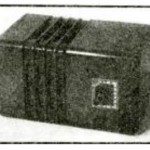
 Roger Dickey of Grand Prairie, Texas, had been a radio serviceman since 1933, and had frequent requests from local farmers for a small economical battery operated radio. Even though the farms weren’t electrified, there were a number of strong local stations, including 50,000 watt WFAA only about 10 miles away. The expensive commercial sets on the market were overkill, and Dickey set out to come up with a better set suited to local needs.
Roger Dickey of Grand Prairie, Texas, had been a radio serviceman since 1933, and had frequent requests from local farmers for a small economical battery operated radio. Even though the farms weren’t electrified, there were a number of strong local stations, including 50,000 watt WFAA only about 10 miles away. The expensive commercial sets on the market were overkill, and Dickey set out to come up with a better set suited to local needs.
He did so with the two-tube TRF set shown here, which he said performed about as well as a superheterodyne. The set used a 1N5GT as RF amplifier, with a dual tube, a 1D8GT serving as detector, and first and second AF stages. A short antenna pulled in all of the local stations during the day. At night, with the longer antenna, the set pulled in WGN and WMAQ from Chicago, WLW Cincinnati, and WSM Nashville, without any overload from the 50,000 watt station just ten miles down the road.
The design was featured in the April 1940 issue of Radio Craft magazine.
